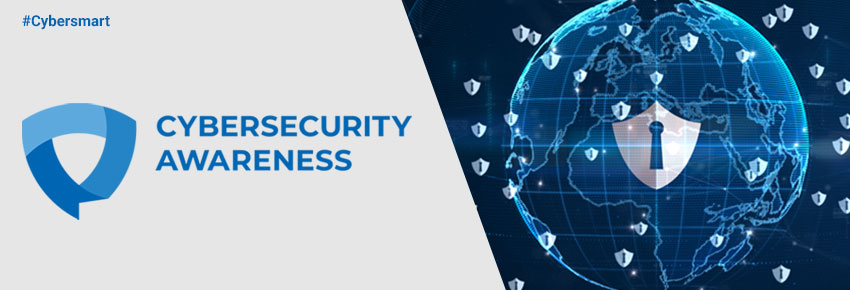Cybersecurity Awareness 2020 – How to be #Cybersmart
Oct 15, 2020 | 42Gears Team

It’s October, and officially the fall season. But October is not just about pumpkin spiced lattes, vibrant fall foliage, and Halloween. October is also the National Cybersecurity Awareness Month. Launched in October 2004, Cybersecurity Awareness Month was an initiative by the National Cyber Security Alliance (NCSA) and the U.S. Department of Homeland Security (DHS) to spread awareness about staying safe online. But in 2020, cybersecurity has become more important than it ever was. The pandemic not only disrupted our lives but also brought unprecedented challenges in its wake. As such, everyone had to turn online to work, learn, and socialize from home. This shift led to an increase in cyberattacks and data breaches.
The Theme for Cybersecurity Awareness 2020
This years’ theme – “Do your part, be #cybersmart” – urges everyone online, including individuals and organizations, to actively take part in emphasizing cybersecurity at home and at work.
Here’s a list of actions that promote cybersecurity awareness and help to stay protected against cyberattacks.
Ensure Endpoint Security
Business devices, including desktops, laptops, smartphones, tablets, printers, routers, and other connected devices, either connects to the Internet or receives and transmits data. As such, all such endpoints need to be protected. So regardless of the kind of business you run, implement an endpoint security solution. If you connect it, protect it.
According to Forbes, “The average cost of a data breach in 2020 will exceed $150 million.”
Enroll your devices into a UEM solution, such as 42Gears SureMDM. This will help get a holistic view of all your devices from a single pane of glass and secure them by applying security policies easily.
Strengthen Network Security
As we know, unsecured Wi-Fi connections increase the risk of cyberattacks manifold. So, you should change your router’s factory-set username and password to a more complicated password. You must also change your password frequently, avoid password sharing, and use a MAC address to prevent unauthorized access. If you are using a company laptop or desktop, you must create a dedicated network by switching onto a virtual local area network (VLAN).
Update Everything
Most software updates contain important security upgrades for recent threats. As such, you can keep potential vulnerabilities at bay by updating your apps, browsers, operating systems, and router regularly. You can even automate and schedule updates through automatic app approvals. In addition, you should uninstall unused programs and applications that have not been patched for a long time.
MDM solutions have built-in capabilities to report and schedule updates. This can help you monitor, push, and stay up-to-date with the latest patches.
Log Out of Your Social Accounts
Irresponsible use of social media can leave breadcrumbs for social media hackers to steal your information using your identity. Yet, most of us make overshare personal information, maintain unused social media accounts, use unsecured mobile devices to access social media channels, and often do not log out of social accounts. Making such common mistakes can increase cybersecurity risks. Social media sites can also be gateways to ransomware and malware. Thus, you must avoid clicking on shortened URLs and suspicious social media ads.
Choose the Right Password
Weak passwords are one of the most common causes of all data breaches. So, practicing good password hygiene, such as using a complex passphrase in combination with multi-factor authentication, can really help. Besides, a password manager can help you generate and remember complex passwords easily.
Think Before You Click
It’s no secret that phishing attacks are getting more sophisticated by the day. Hackers pose as trustworthy people and trick people into sharing personal details or account information. Thus, you should resist clicking on email attachments with malicious links.
According to a survey, there was a 67% increase in malicious phishing emails during the pandemic in April 2020. These emails were sent by scammers impersonating the UK government, the WHO, and the Centre for Disease Control and Prevention. So, watch out for COVID-19-related email scams with job offers, medication advice, and donations.
Improve Data Security
Backing up personal and work-related data can help improve data security. Since you can lose important data if your hard drive crashes, you lose your device, or become a victim of malware attacks, you must implement tools that boast granular backup and recovery metrics and reporting. For example, encrypting data with Bitlocker or FileVault policies can protect personally identifiable information that may be vulnerable to theft and loss, and using the Time Machine option on macOS devices can help make a backup at home.
Conclusion
Since almost everyone is working from home now, the onus to practice cyber safety also lies on everyone. Cybersecurity awareness can go a long way in creating a digital environment that’s protected against hackers. 42Gears strives to empower businesses to do their bit in protecting our shared cyberspace through device management. You can go through our resources for any guidance you need to ensure security and compliance for a remote workforce.
Manage, monitor, secure all your
business devices remotely
Subscribe for our free newsletter
